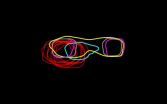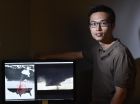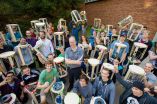Disney Research demonstrates LEDs that use visible light to talk to each other and internet
System's interoperability supports both internet of things and internet of toys
2015-09-11
(Press-News.org) The light that typically floods homes, offices and public buildings could provide something more than illumination. Scientists at Disney Research and ETH Zurich have demonstrated that light could be a medium for light bulbs to communicate - with each other, with objects and with the Internet.
Transmitting signals via light is nothing new; Alexander Graham Bell showed that speech could be conveyed with light in the 1880s, years before speech was first transmitted via radio. The Disney researchers, however, have created networking technology that makes it possible for LED lights not only to communicate with each other, but to do so in a way that is compatible with the Internet and its technical protocols.
Stefan Mangold, who heads Disney Research's wireless research group, says these advances could give Visible Light Communication (VLC) an important role in the growing Internet of Things - the idea that objects can communicate with each other and share information to create smart environments.
"Communication with light enables a true Internet of Things as consumer devices that are equipped with LEDs but not radio links could be transformed into interactive communication nodes," Mangold said. "We're not just talking about sensors, smartphones and appliances. This easily could include toys that have LEDs, creating an Internet of Toys in which toys can be accessed, monitored and acted on remotely."
Mangold and his colleagues presented their findings Sept. 11 at VLCS '15, the ACM Workshop on Visible Light Communication Systems in Paris, France.
The VLC network the researchers used off-the-shelf commercial LED light bulbs that they then modified so that they could send and receive visible light signals. These modifications included a System-on-a-Chip running the Linux operating system, a VLC controller module with the protocol software and an additional power supply for the added electronics.
The researchers created software that makes the signals transmitted through this hardware compatible with Internet protocols. They were thus able to create networks with a throughput of up to 1 kilobit per second. These VLC-enabled bulbs could be used to broadcast beacons making it possible to detect the location of objects, linked into a network to route signal traffic or could be used to communicate with objects.
"The ubiquitous presence of LED-based light bulbs that can be enhanced with VLC functionality, and the availability of LED-equipped devices, unleashes a wide range of opportunities and applications," Mangold said.
INFORMATION:
The research team included Stefan Schmid, a Ph.D. student at Disney Research and ETH Zurich; Theodoros Bourchas, a research assistant at ETH Zurich and a Disney Research intern, and Thomas Gross, professor of computer science at ETH Zurich.
For more information, including a video, please visit the project web site http://www.disneyresearch.com/publication/Linux-Light-Bulbs/.
About Disney Research
Disney Research is a network of research laboratories supporting The Walt Disney Company. Its purpose is to pursue scientific and technological innovation to advance the company's broad media and entertainment efforts. Vice Presidents Jessica Hodgins and Markus Gross manage Disney Research facilities in Los Angeles, Pittsburgh, Zürich, and Boston and work closely with the Pixar and ILM research groups in the San Francisco Bay Area. Research topics include computer graphics, animation, video processing, computer vision, robotics, wireless & mobile computing, human-computer interaction, displays, behavioral economics, and machine learning.
ELSE PRESS RELEASES FROM THIS DATE:
2015-09-11
KANSAS CITY, MO -- Cellular mitosis depends in part on small organelles that extend spindles to pull apart chromosome pairs. Before they can perform this and other essential tasks, these tiny cylindrical structures -- known as centrioles in animals and spindle pole bodies (SPBs) in yeast -- must themselves duplicate.
However, much about this nanoscale process has remained veiled by the limits of current microscopy. Optical approaches cannot resolve objects below certain wavelength limits, while non-optical approaches like electron microscopy (EM) can only study nonliving ...
2015-09-11
What if tornado activity could be forecasted months, even seasons in advance? Thanks to a new model developed at the University of Toronto Scarborough, that ability could soon become a reality.
"The aim is to predict ahead to the following year or subsequent years about whether we'll get above or below average tornado activity in a given area," says Vincent Cheng, a postdoctoral fellow in UTSC's Ecological Modelling Lab.
The model, developed by Cheng, Professor George Arhonditsis and Professor Bill Gough in UTSC's Climate Lab along with colleagues at Environment Canada, ...
2015-09-11
Genetic mutations called "escape variants" in the deadly Ebola virus appear to block the ability of antibody-based treatments to ward off infection, according to a team of U.S. Army scientists and collaborators. Their findings, published online this week in the journal Cell Reports, have implications for the continued development of therapeutics to treat Ebola virus disease, which has claimed the lives of over 11,000 people in West Africa since last year.
Ebola virus overruns the immune system, thus overwhelming the host's ability to fight off the infection. One strategy ...
2015-09-11
PhD candidate Matt Shultz has discovered the first massive binary star, epsilon Lupi, in which both stars have magnetic fields. A binary star is a star system consisting of two or more stars, orbiting around their common centre of mass.
For the past few years, the BinaMIcS (Binarity and Magnetic Interactions in various classes of Stars) collaboration, formed to study the magnetic properties of close binaries, has been trying to find such an object. They have now discovered one using the Canada-France-Hawaii Telescope.
"The origin of magnetism amongst massive stars is ...
2015-09-11
LEXINGTON, Ky. (Sept. 8, 2015) -- A new University of Kentucky study in the journal mBio shows that tissue cysts of the parasite Toxoplasma gondii, long thought to be dormant, are quite active.
Led by Anthony Sinai, professor at the UK College of Medicine, the study has significant implications on the understanding of chronic toxoplasmosis in the brain, a condition suggested to contribute to a range of neurological diseases including schizophrenia in humans, and the modulation of behavior in rodents.
Toxoplasmosis can be acquired from the droppings of infected cats ...
2015-09-11
Using metallic osmium (Os) in experimentation, an international group of researchers have demonstrated that ultra-high pressures cause core electrons to interplay, which results in experimentally observed anomalies in the compression behavior of the material.
Os is one of Earth's most exceptional elemental materials, possessing the highest known density at ambient pressure, one of the highest cohesive energies and melting temperatures, and an incompressibility that is almost comparable to that of diamond.
Researchers believe that the ability to affect core electrons ...
2015-09-11
Open source lab equipment is the focus of a new study, published in Science and Public Policy. Joshua Pearce, an associate professor of materials science and engineering as well as electrical and computer engineering at Michigan Tech, led the research. Pearce proposes that instead of spending millions of dollars every year replacing quickly obsolescent equipment, that money could be redirected to developing open source tools that are "upgradeable and transformable--they will be continuously updated" using digital manufacturing techniques such as 3-D printing.
The benefits ...
2015-09-11
The politics of climate change are often depicted as a simple battle, between environmentalists and particular industries, over government policy. That's not wrong, but it's only a rough sketch of the matter. Now a paper co-authored by MIT economist Christopher Knittel fills in some important details of the picture, revealing an essential mechanism that underlies the politics of the climate battle.
Specifically, as Knittel and his colleagues demonstrate, at least one climate policy enacted by Congress -- on transportation fuels -- contains a crucial asymmetry: It imposes ...
2015-09-11
The aging process is associated with declines in brain function, including memory and how fast our brain processes information, yet previous research has found that higher levels of cardiorespiratory fitness in older adults leads to better executive function in the brain, which helps with reasoning and problem solving. Higher cardiorespiratory fitness levels have also been found to increase brain volume in key brain regions.
A new study from a team at the Beckman Institute for Advanced Science and Technology at the University of Illinois reveals the connection between ...
2015-09-11
UPTON, NY--In the Daya Bay region of China, about 55 kilometers northeast of Hong Kong, a research project is underway to study ghostlike, elusive particles called neutrinos. Today, the international Daya Bay Collaboration announces new findings on the measurements of neutrinos, paving the way forward for further neutrino research, and confirming that the Daya Bay neutrino experiment continues to be one to watch.
The latest findings involve measurements that track the way neutrinos change types or flavors as they move, a characteristic called neutrino oscillation. By ...
LAST 30 PRESS RELEASES:
[Press-News.org] Disney Research demonstrates LEDs that use visible light to talk to each other and internet
System's interoperability supports both internet of things and internet of toys


